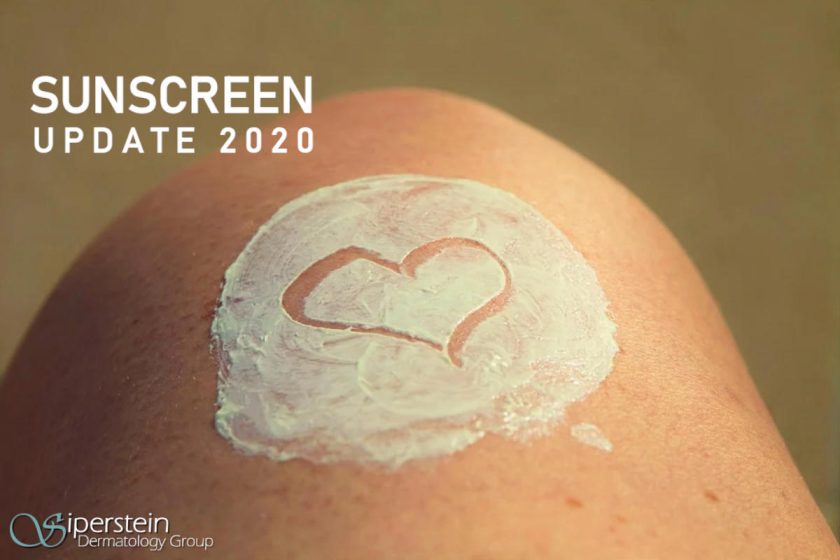Summer is fast approaching! With the beaches of Palm Beach County tentatively set to reopen on May 18th, 2020, we at Siperstein Dermatology feel it’s a great time to talk about sunscreen.
So, what’s new in the sunscreen world? How can using sunscreen help you maintain healthy skin? Read on for all the updates!
What Sunscreen Should I Bring on Vacation?
Dermatologists often recommend SPF 30+ for day-to-day use, but during a vacation where there is high UV radiation exposure over multiple consecutive days (beach, watersports, snow sports), SPF 30+ is simply not enough.
Is SPF 100+ Better Than SPF 50+?
In April 2020, a published study from Wayne State University showed that sunscreen with SPF 100+ was significantly more protective against sunburn than SPF 50+ under actual beach conditions.
Participants in this study, which took place in Florida’s Upham Beach in St. Petersburg, were randomly assigned to use SPF 50+ on one side of the body and SPF 100+ on the other side. Researchers found that the side with SPF 50+ sunburned earlier in the vacation (after day one of sun exposure, instead of day three for SPF 100+) and were more likely to be sunburned by the end of the vacation.
This study is highly relevant to us because one, it reflects real life usage of sunscreen, not a controlled laboratory setting. Two, it was a scientifically rigorous study that assessed sunburn via colorimetry and diffuse reflectance spectroscopy. Thirdly, the study was done on a beach in Florida!
So, before you head out this summer to your local beach, make sure you have your SPF 100+ sunscreen with you!
Speaking of SPF 100+ Sunscreens, What Brands Do You Recommend?
There are many brands of sunscreens, but only a handful that carry SPF 100+.
Our two favorites are: Neutrogena’s Ultra Sheer Dry Touch Water Resistant Sunscreen SPF 100+ and La Roche Posay’s Anthelios Melt-in Milk Sunscreen for Face and Body SPF 100+.
These two are both sunscreen lotions. There are also SPF 100+ sunscreens that come as sprays. Spray applications usually vary more and are patchier, so make sure you give yourself a double spray to cover any areas you may have missed the first time around.
Regardless of the SPF 100+ sunscreen you choose, be sure to apply at least 15 minutes prior to sun exposure and ideally after every 60 minutes of water exposure.
My 2021 Vacation Destination Has Banned the Use of Sunscreens with Oxybenzone & Octinoxate: What Sunscreens Can I Use to Protect My Skin?
Due to concerns of coral reef bleaching, many popular vacation destinations around the world have started banning the sale of sunscreens containing oxybenzone and octinoxate.
Destinations that have enacted bans include Hawaii, Key West, U.S. Virgin Islands, Aruba, Bonaire, Palau, and even some parts of Mexico. Most of these bans start January 2021, so you have plenty of time to prepare your vacation sun protection plan!
There are many sunscreens that don’t contain oxybenzone and octinoxate.
Some of our favorites include: La Roche Posay’s Anthelios Melt-in Milk Sunscreen for Face and Body SPF 100, Elta MD UV Active Broad Spectrum SPF 50+, Elta MD UV Pure, Neutrogena Sheer Zinc SPF 50, Neutrogena Ultra-Sheer Dry Touch SPF 55, Neutrogena Pure + Free Baby SPF 50, and Sun Bum Original Sunscreen SPF 50.
We have samples of many of these sunscreens in our office, so be sure to ask us at your next office visit!
What’s the Difference Between Mineral and Chemical Sunscreens?
Mineral sunscreens and chemical sunscreens differ in their ingredients and their method of UV radiation protection.
While mineral sunscreens contain ingredients that largely reflect UV radiation, chemical sunscreens contain ingredients that absorb UV radiation. Common mineral sunscreen ingredients include zinc oxide, and titanium dioxide. Common chemical sunscreen ingredients include avobenzone, homosalate, octocrylene, oxybenzone, octinoxate, and many more.
Many of our patients prefer chemical sunscreens because of the ease of application (aerosol sprays are almost exclusively chemical sunscreens), high SPF formulations, and cosmetic elegance (leaves minimal streaks or residue on the skin).
Other patients prefer mineral sunscreen due to its broader-spectrum UV coverage and undeniable safety record (mostly for children and pregnant/lactating women).
What Mineral Sunscreens Do You Recommend?
Finding a high-quality, mineral sunscreen can be challenging because most sunscreens have chemical ingredients. Drop by our office or visit our website to find more information about our favorite mineral sunscreens.
Our Siperstein Dermatology in-house formulations of mineral sunscreens are some of the best sunscreens on the market because of their high zinc oxide content.
Sunscreens For The Face
- Siperstein Tinted Physical Sunscreen SPF 50+ (tinted and non-tinted available)
- Siperstein Sheer zinc oxide Sunscreen 50+ with antioxidant (non-tinted)
- Revision Intellishade Original (tinted)
- Brush on Block (Brush-on Powder, tinted)
- EltaMD UV Physical SPF 41(tinted)
Sunscreens For The Body (All Non-Tinted)
- EltaMD UV Pure SPF 47
- Neutrogena Sheer Zinc SPF 50
- Neutrogena Pure + Free Baby SPF 50
The Healthy Skin Experts In Boca Raton
As usual, if you have any questions regarding sunscreens, be sure to ask one of our dermatologists at your next visit. We are your go-to-experts on all things sun-protection related and are more than happy to answer all your questions. Call us today at 561-955-8885.


